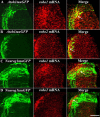Manipulating Robo expression in vivo perturbs commissural axon pathfinding in the chick spinal cord
- PMID: 18753371
- PMCID: PMC2886497
- DOI: 10.1523/JNEUROSCI.1479-08.2008
Manipulating Robo expression in vivo perturbs commissural axon pathfinding in the chick spinal cord
Abstract
In vertebrate embryos, most spinal commissural axons cross the ventral midline (VM) and project either alongside or significant distances away from the floor plate (FP). The upregulation of repulsive Robo1/2 receptors on postcrossing commissural axons, in mammals, presumably allows these axons to respond to the midline-associated repellents, Slit1-3, facilitating their expulsion from, and prohibiting their reentry into, the FP. Compelling data suggest that Robo3 represses Robo1/2 function on precrossing axons and that Robo1/2 inhibit attractive guidance receptors on postcrossing axons, thereby ensuring that decussated axons are selectively responsive to midline Slits. However, whether Robo1/2 expel decussated commissural axons from the VM and/or prevent their reentry into the FP has not been explicitly established in vivo. Furthermore, some commissural axons do not require Robo1/2 to elaborate appropriate contralateral projections in the mouse spinal cord. Here, we use unilateral in ovo electroporation together with Atoh1 and Neurog1 enhancer elements to visualize, and assess the consequences of manipulating Robo expression on, dl1 and dl2 chick commissural axons. In response to misexpressing a cytoplasmic truncation of Robo1 and/or Robo2, which should block all Robo-ligand interactions, postcrossing commissural axons extend alongside, but do not project away from or reenter the FP. In contrast, misexpression of full-length Robo2 prevents many commissural axons from crossing the VM. Together, these findings support key and selective in vivo roles for Robo receptors in presumably altering the responsiveness of decussated commissural axons and facilitating their expulsion from the VM within the chick spinal cord.
Figures









Similar articles
-
Collaborative and specialized functions of Robo1 and Robo2 in spinal commissural axon guidance.J Neurosci. 2010 Jul 14;30(28):9445-53. doi: 10.1523/JNEUROSCI.6290-09.2010. J Neurosci. 2010. PMID: 20631173 Free PMC article.
-
Leaving the midline: how Robo receptors regulate the guidance of post-crossing spinal commissural axons.Cell Adh Migr. 2009 Jul-Sep;3(3):300-4. doi: 10.4161/cam.3.3.9156. Epub 2009 Jul 2. Cell Adh Migr. 2009. PMID: 19556886 Free PMC article.
-
Crucial roles of Robo proteins in midline crossing of cerebellofugal axons and lack of their up-regulation after midline crossing.Neural Dev. 2008 Nov 5;3:29. doi: 10.1186/1749-8104-3-29. Neural Dev. 2008. PMID: 18986510 Free PMC article.
-
The Robo3 receptor, a key player in the development, evolution, and function of commissural systems.Dev Neurobiol. 2017 Jul;77(7):876-890. doi: 10.1002/dneu.22478. Epub 2017 May 5. Dev Neurobiol. 2017. PMID: 28033646 Review.
-
Axon guidance at the midline choice point.Dev Dyn. 2001 Jun;221(2):154-81. doi: 10.1002/dvdy.1143. Dev Dyn. 2001. PMID: 11376484 Review.
Cited by
-
Guidance of longitudinally projecting axons in the developing central nervous system.Front Mol Neurosci. 2012 May 4;5:59. doi: 10.3389/fnmol.2012.00059. eCollection 2012. Front Mol Neurosci. 2012. PMID: 22586366 Free PMC article.
-
Axonal patterns and targets of dA1 interneurons in the chick hindbrain.J Neurosci. 2012 Apr 25;32(17):5757-71. doi: 10.1523/JNEUROSCI.4231-11.2012. J Neurosci. 2012. PMID: 22539838 Free PMC article.
-
Neurogenesis redirects β-catenin from adherens junctions to the nucleus to promote axonal growth.Development. 2023 Aug 15;150(16):dev201651. doi: 10.1242/dev.201651. Epub 2023 Aug 24. Development. 2023. PMID: 37519286 Free PMC article.
-
Motor and dorsal root ganglion axons serve as choice points for the ipsilateral turning of dI3 axons.J Neurosci. 2010 Nov 17;30(46):15546-57. doi: 10.1523/JNEUROSCI.2380-10.2010. J Neurosci. 2010. PMID: 21084609 Free PMC article.
-
Evidence for a role of srGAP3 in the positioning of commissural axons within the ventrolateral funiculus of the mouse spinal cord.PLoS One. 2011;6(5):e19887. doi: 10.1371/journal.pone.0019887. Epub 2011 May 31. PLoS One. 2011. PMID: 21655271 Free PMC article.
References
-
- Briscoe J, Sussel L, Serup P, Hartigan-O'Connor D, Jessell TM, Rubenstein JL, Ericson J. Homeobox gene Nkx2.2 and specification of neuronal identity by graded Sonic hedgehog signalling. Nature. 1999;398:622–627. - PubMed
-
- Brittis PA, Lu Q, Flanagan JG. Axonal protein synthesis provides a mechanism for localized regulation at an intermediate target. Cell. 2002;110:223–235. - PubMed
-
- Charron F, Stein E, Jeong J, McMahon AP, Tessier-Lavigne M. The morphogen Sonic Hedgehog is an axonal chemoattractant that collaborates with Netrin-1 in midline axon guidance. Cell. 2003;113:11–23. - PubMed
-
- Chen Z, Gore BB, Long H, Ma L, Tessier-Lavigne M. Alternative splicing of the Robo3 axon guidance receptor governs the midline switch from attraction to repulsion. Neuron. 2008;58:325–332. - PubMed
-
- Chesnutt C, Niswander L. Plasmid-based short-hairpin RNA interference in the chicken embryo. Genesis. 2004;39:73–78. - PubMed
Publication types
MeSH terms
Substances
Grants and funding
LinkOut - more resources
Full Text Sources
